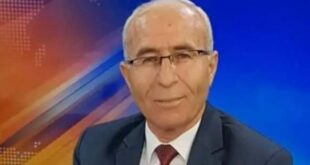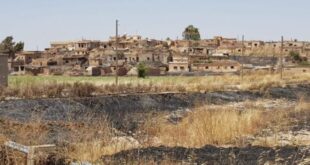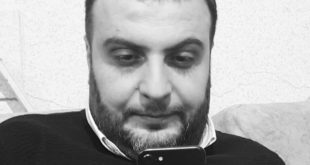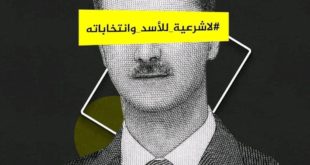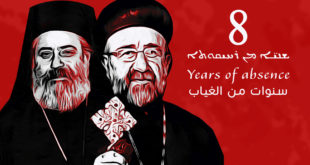10 Jul 2011
Sunday Telegraph Special Correspondent in Hama
Syrian musician Ibrahim Qashoush sang of freedom – until he paid the price. But as The Sunday Telegraph saw during secret travels across the country, Syrians are determined to keep up pressure to oust President Assad.
————
He was no pop superstar, but Ibrahim Qashoush wrote the stand-out song of the Syrian uprising.
"It’s time to leave, Bashar," its lyrics go. "Freedom is near."
Some of its verses were frankly rude: "Screw you, Assad," says one line.
But the singer paid the price for his fleeting fame.
On Monday, according to a video that has circulated the country online, his body was found floating in the River Orontes in his home-town, Hama. His throat had been cut; in the footage, his head lolls horribly.
On an evening in late June, Qashoush’s voice had soared over one of the crowds as some of the biggest protests yet in the Arab world came to the boil. But as Assad’s troops moved in, they found and dealt with him, overseas dissidents have confirmed.
Hundreds of thousands had gathered in Hama, a town in northern Syria once best known for its centuries-old waterwheels and more recently as the centre of the last rebellion against Assad rule.
In 1982, President Bashar al-Assad’s father Hafez sent tanks to end that opposition with great ferocity, killing between 10,000 and 20,000 people. Now Bashar may be forced to order a repeat of the operation, as Hama becomes once again the focus of resistance to the regime.
In the wake of the protest at which Qashoush sang, and an even bigger one last Friday when an estimated 250,000 of the city’s population again risked tank shells and sniper bullets to pour out of their homes, President Assad’s overstretched forces are finding the city slipping beyond their grasp.
The army withdrew after killing at least 40 at the beginning of June. More died again last week as it tried to re-enter. But even if it succeeds, Hama’s truculence may just be repeated in another city.
"Look at Syria’s 14 provinces, they’re all protesting," one man said. "The army chases these protests all over but as soon as they leave, the people just come out again."
The Sunday Telegraph secretly visited Hama during a week-long undercover journey around a nation in revolt – a journey which showed how tenuous government control has become, despite a crackdown that has claimed more than 1,400 lives since March.
Using pseudonyms, booking diversionary journeys, slipping quietly into blockaded towns and hiding with protesters, The Sunday Telegraph criss-crossed the nation and witnessed a Syria of "freed" towns, vast anti-regime demonstrations, violent melees and angry gunfights.
It is the Syria that President Assad wants no one see, and it is the reason why he has sought to arrest, censor or ban foreign journalists.
Hama, Syria’s fourth city, has become a vital battlefield. The scars can still be seen from the brutal aftermath of the 1982 clash between the Muslim Brotherhood and the regime of Hafez al-Assad.
Within minutes of noticing a foreigner, residents began to boast of the impending fall of the regime.
A butcher, Omar was brimming with pride as he explained why. "Look around, the government is finished in Hama," he said. "The army came here and they killed many and they stole. But we kept coming out. No matter how many times the army comes, we’ll never give in now."
A young man approached, his eyes shining with excitement, and lifted his shirt to display the large knife he was carrying, tucked inside the belt of his trousers, "in case the army comes back". His gesture was all the more striking because it took place in front of the town’s police station.
Elsewhere men gravitated, seemingly instinctively, towards the renowned clock tower that stands in the city’s central square, and within 10 minutes some 10,000 had gathered, many carrying Syrian flags, for that day’s protests. Many warned that as a westerner I would be targeted by the government snipers thought to be lying on the roof tops, but none seemed concerned on their own behalf and in fact there was no shooting.
Soon three separate columns of marchers were pouring into the square, and it was if half the city was out on the streets, young and old, male and female. A group of women in jet-black burkas sang revolutionary songs. Others, some with their heads covered, some not, chimed in from the crowd.
"This Assad family are murderers and criminals," said one resident, filled with emotion at the chance to tell his story to a foreign observer. "Tell everyone: the people of Hama say that this regime is finished."
It was a message that I heard repeatedly as I travelled across Syria, sometimes to places where it seemed the regime had completely abandoned any effort to keep control.
In the dusty north-eastern city of Deir Resor, where six died in recent clashes, even the totems of the regime have now vanished; pictures of President Assad and his father, Hafez, had been destroyed and their statues removed.
Straddling the banks of the Euphrates River, Deir Resor is close to the Iraqi border. Even the local Arabic is nearer Baghdad than Damascus.
But despite its importance the government had apparently left only a tiny handful of security forces to fend for themselves. Late in the evening gunfire could be heard, and then a firefight a few streets away – brief, but enough to make the soldiers standing by a sandbagged police station jittery.
In a café where young men were playing cards, one described how the government had lost control of the city. "The army tried to come into Deir Resor a few weeks ago, but they soon had to retreat," he said. "The government know the northern clans are armed, they have support from Iraq, and if they are attacked they will fight.
"But this is the biggest town in the area and if it is anti-government it means the entire east of Syria is too."
In other places the security forces have acted so decisively and brutally to quell dissent that life will take a long time to return to normal. In several villages in the north, I saw scorched buildings and army tanks still stationed in fields where – incongruously – farmers continued their work.
And throughout the small farming town of Jisr al-Shugour, where last month the government sent tanks in revenge for the deaths of 120 soldiers who it claimed had been killed by terrorists, troops of the hated Fourth Division are still deployed in force.
In fact, residents say, the soldiers were killed by the military after they refused to fire on unarmed protesters and tried instead to defect. Whatever the truth, some 10,000 residents fled across the border to Turkey to evade the avenging army.
The Fourth Division is the de facto private army of the president’s younger brother, Maher al-Assad, and its soldiers are Syria’s best equipped and most loyal. It can, however, be a law unto itself: The Sunday Telegraph has been told of an incident in which Fourth Division soldiers called at Syria’s central bank and left soon afterwards with bulging green holdalls, presumed to contain hard currency to pay for their depredations elsewhere.
Now it has established a field headquarters within striking distance of Jisr al-Shugour, and around the town its tanks stood positioned to fire straight into the windows of passing traffic. Their tracks have gouged deep scars into the tarmac.
There was none of the gentle bustle expected from a thousand similar Syrian towns. The shops remained shuttered, surrounding fields lay untended and burned houses served as stark reminders of the potential cost of resisting the regime. Army patrols drifted lazily through the greenery, clearly under no perceptible threat of attack.
To the west, past the small village where a pristine mausoleum houses the remains of the president’s father – a place of pilgrimage for loyalists where visitors snap vigorously to attention – lie the coastal towns and cities which the regime cannot afford to lose.
The streets that wind down to the industrial port of Lattakia were littered with pro-regime paraphernalia as The Sunday Telegraph visited, and pro-government shabiha militia, the most feared of all the forces because of their savagery when unleashed, idled in pick-up trucks near the main police station, ready to intervene if necessary. In the main square was a noisy pro-Assad gathering, where support did not appear to be stage-managed.
Yet even here a statue of the president’s father was under armed guard against sabotage, and there was plenty of other evidence of dissent.
In the local graveyard, some of whose simple plots had been recently dug, a resident, Abu Hamza, described the violence that he said had led to the deaths of many young men.
Articulate, educated but jobless, he epitomised the challenge facing the government of Syria. "In March it was close to a massacre here," he said.
"They brought in army snipers to kill many protesters. The government understood that it cannot lose this town – it’s from places like this that its support must come.
"For 10 days the army killed everyone walking the streets. I used to think that Israel was our enemy. But even the Israelis use rubber bullets, shoot at people’s legs, allow ambulances to come and take people to hospital. Now I know the Syrian regime is our real enemy."
Adding to the challenge for regime is the impression that the bottom is beginning to fall out of the Syrian economy. Queues of cars snake along the roads outside petrol stations, waiting for the next delivery of fuel to replenish their empty tanks. Street money changers, hungry for dollars, trade the Syrian currency at a 20 per cent discount from the official rate.
Hotel rooms around the country are empty as tourism has collapsed, and foreign investors have scaled down projects or withdrawn funding altogether.
Because they believe that with one more push the Assads will be gone, many protesters reject the regime’s attempts to foster dialogue with the opposition and have refused to take part in an exploratory conference of regime spokesmen and seasoned Syrian dissidents due to be held today.
Others have put forward a discussion document that envisions the regime remaining in place while giving up "a large part of its control over state and society".
For there are still parts of Syria where support for the leadership remains strong. The crucial trading city of Aleppo has been predominantly quiet throughout the uprising; so, too has the centre of the capital, Damascus, although there have been major protests in its suburbs.
But for the demonstrators insist such support is waning, and say that as the protests grow those previously loyal or cowed lose their inhibitions. For every dissident taking part in today’s dialogue, another rejects it. Some are in hiding.
Protesters reject government allegations that they are religious zealot and extremists, but say they have been radicalised by what they have witnessed over the last few months. The young man in the graveyard, Abu Hamza, embraced the ideals of democracy – and bemoaned those who he believes are helping prop up his country’s unpopular regime.
He also set his face against foreign intervention, even in his favour.
"There is a conspiracy – one of Iran, China, Russia, Hezbollah and the president against the people of Syria," he said. "But we Syrians must fight alone."
The regime, he said, would not give up lightly, and the burial plots over which he was watching would not be the last; yet, he added, the regime was no longer omnipotent.
"The regime must fight for Lattakia but it can’t fight everywhere all of the time," he said.
"Bashar is dividing the country between those places the government can fight for now – and those he will come back for, if the Syrian people weaken and give him the chance."
Additional reporting: Richard Spencer, Middle East Correspondent
 Assyrian Democratic Organization ADO
Assyrian Democratic Organization ADO

